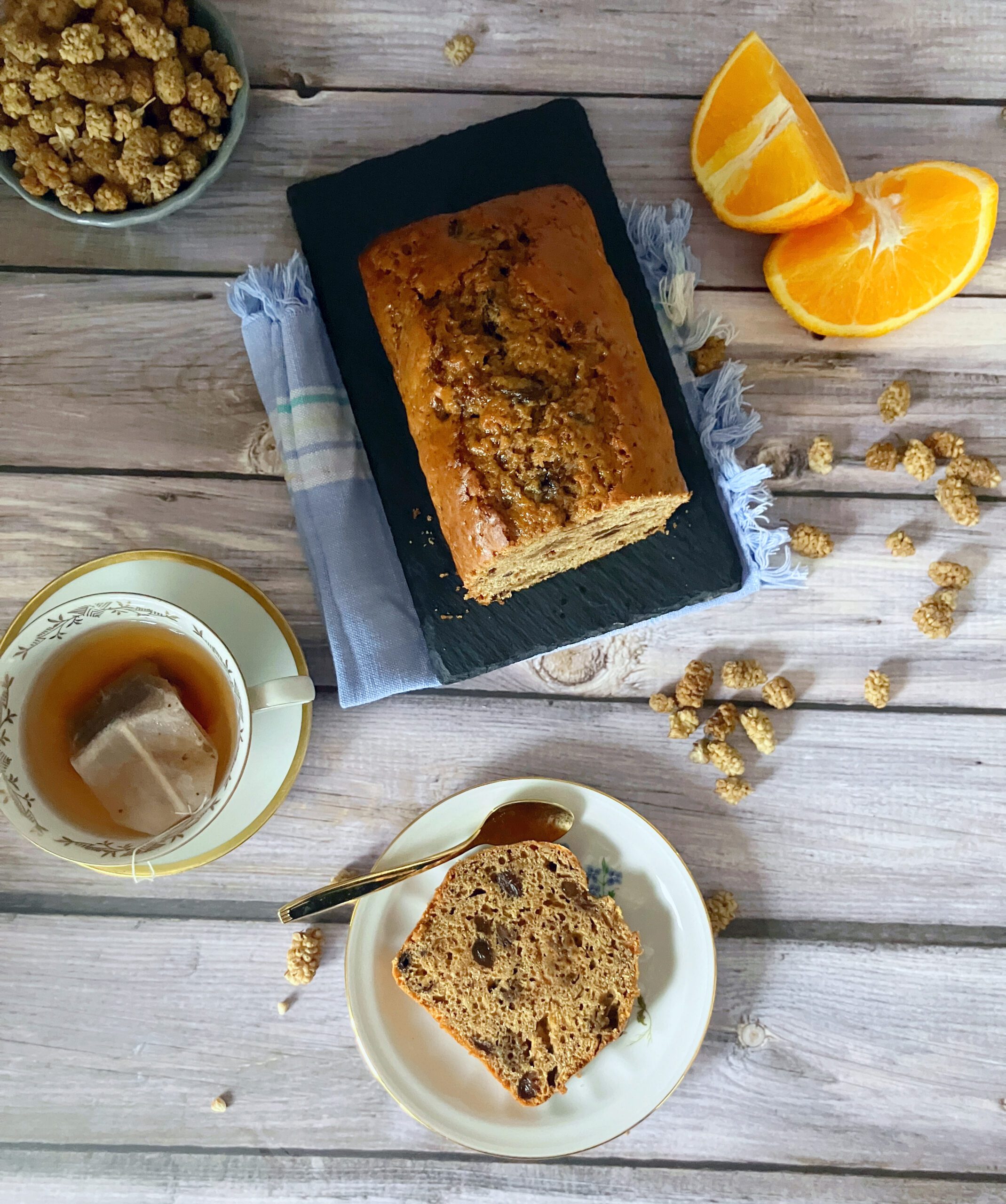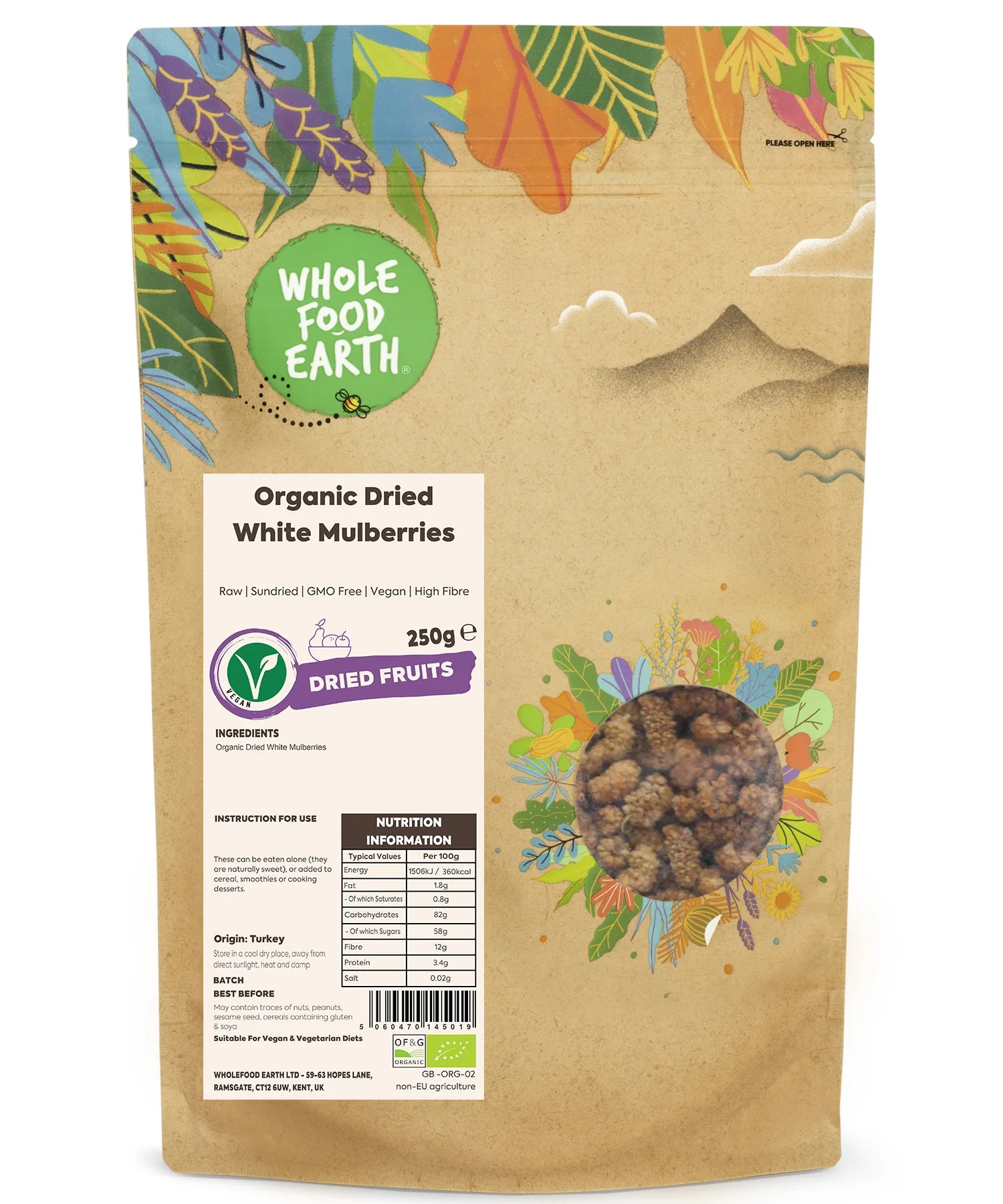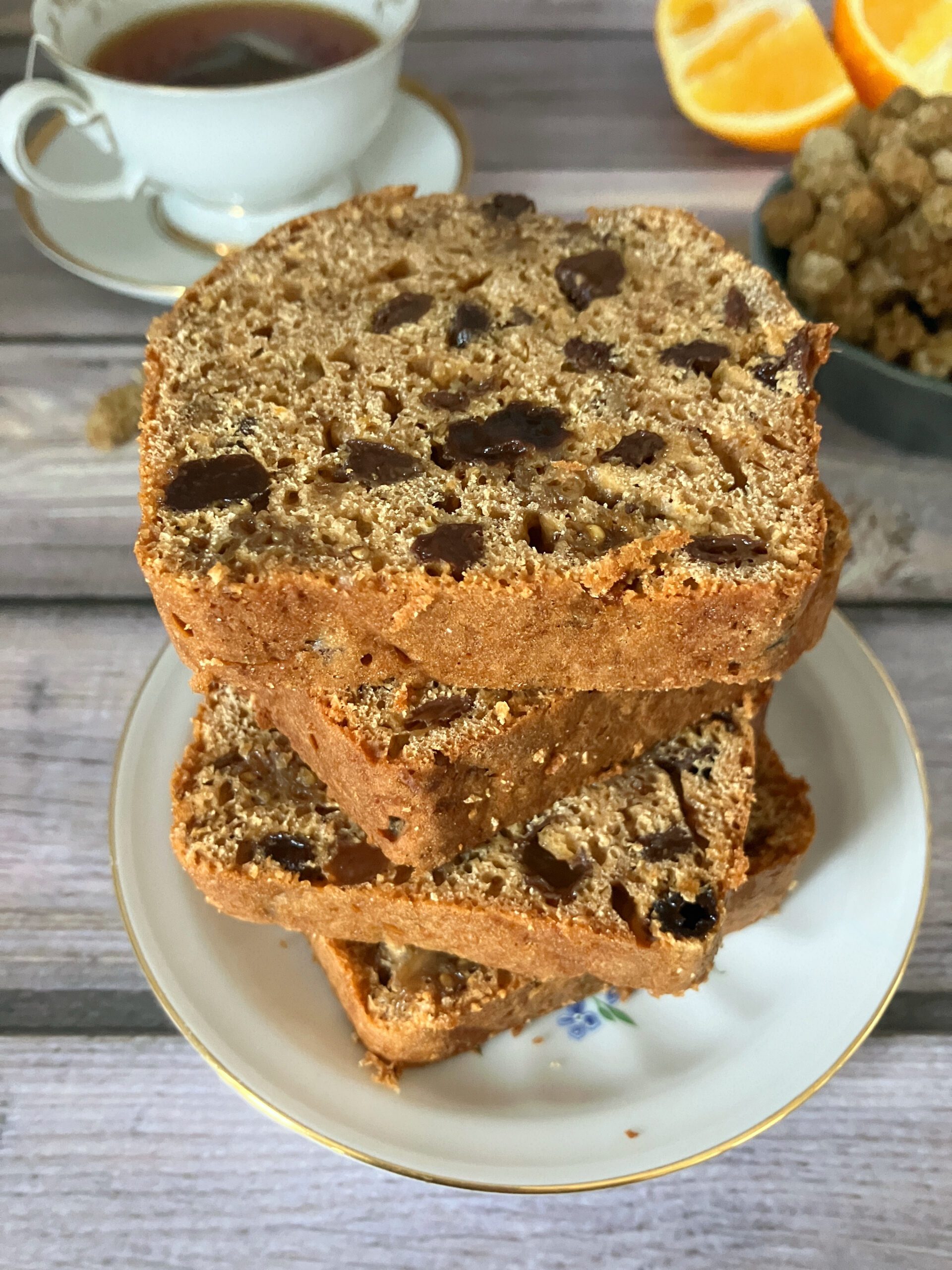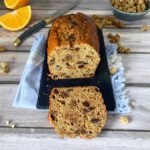Dried White Mulberry & Date Syrup Tea Loaf
This dried white mulberry tea loaf was created in collaboration with Whole Food Earth. I received a complimentary bag of organic dried white mulberries and was compensated for creating the recipe and writing this post, which contains links to their products.
My cake is a wholesome, lighter twist on a classic British tea loaf. It has no butter or oil and is naturally sweetened with raisins, dried mulberries and date syrup. Infused with fragrant orange zest and black tea, it bakes into a moist loaf that’s the perfect accompaniment for your favourite cuppa.
It is delicious on its own, but because it’s a lighter cake, there’s room to indulge with a little butter if you like.
The right fit: Whole Food Earth
I receive quite a few collaboration offers, but I’m selective about who I work with. For me, baking isn’t just about creating something delicious. It’s also about using simple, wholesome ingredients wherever possible.
Whole Food Earth aligns beautifully with this philosophy. They focus on high-quality, traceable whole ingredients such as grains, nuts, dried fruits, seeds, and natural sweeteners. Their approach mirrors my own: nourishing food doesn’t need to be complicated, and thoughtful ingredients can elevate everyday baking without relying on overly processed shortcuts.
Their idea was to send me some organic dried white mulberries. This was met with both excitement and a tiny hint of apprehension. I had never eaten a mulberry in my life, fresh or dried, and honestly had no idea what to expect. They definitely surprised me: chewy, sweet, and very caramel-like. Delicious.
I received a generous 1kg bag, and since they arrived, I’ve been grabbing them by the handful as a quick snack. They’ve also been stirred into my breakfast granola, sprinkled over Greek yoghurt, and my mind is already whirring with the possibilities of what else I can bake with them. Watch this space.
Click the image below to explore the organic dried mulberries available from Whole Food Earth.
What is a tea loaf?
Despite the name, a tea loaf is more like a cake than a bread.
Its title derives from two key features. Firstly, the dried fruit is soaked overnight in a strong black tea, which causes it to swell and rehydrate. As the fruit absorbs the tea, it takes on some of its subtle nuances, which carry through into the baked loaf. The moisture from the plumped up fruit also helps keep the surrounding crumb tender and moist, so the loaf isn’t dry despite being dense. The second part of the name refers to the shape of the cake and the pan it is baked in.
Tea loaves became popular in 19th-century Britain as a practical, everyday bake. They made good use of the import trade from India, often using Assam, a robust, inexpensive black tea. The cake relied on simple pantry ingredients such as dried fruit, flour, sugar, eggs, or milk, and could be kept for several days without losing texture or flavour.
Although more modern versions do contain butter, earlier tea loaves had no added fat, making them a lighter alternative to fruit cakes, which were generally reserved for special occasions. They also contained much less sugar than their heavier counterparts.
Spices were common place, and tea loaves often included cinnamon, nutmeg, and sometimes allspice or cloves. However, they were always in subtle amounts so the fruit remained the star, unlike richer fruit cakes. This was partly practical, as strong spices were expensive, but also a matter of taste.
While often served alongside tea, they weren’t reserved for the wealthy. Anyone could partake in a slice, and the loaf could appear in both modest homes and grand households.
My dried mulberry and date syrup tea loaf recipe
After a little thinking, I decided on using the dried mulberries to create my take on a classic tea loaf.
After several rounds of testing, tasting, and tweaking, I am absolutely thrilled with the result. It is a fruit-packed cake bursting with natural sweetness, and one of the nicest things I’ve eaten in a long time. I had four slices while taking the photos.
The raisins and dried white mulberries are prepared by giving them a long soak in black tea. These infuse the cake with a subtle flavour as it bakes. When the fruit is gorgeously plumped up and ready, the ingredients come together quickly, and the batter is ready to bake in under 10 minutes.
The tea loaf rises to a golden-brown dome and after it is cooled, is brushed with a light glaze of date syrup and fresh orange juice. This adds a gentle shimmer and a citrus note that makes this tea loaf feel a little bit special.
As a small batch cake it yields 8–10 easily sliced pieces. Perfect for sharing, or keeping all to yourself. No judgment here.
A lighter tea loaf: how it differs from traditional bakes
Although my tea loaf follows the traditional path of using a loaf pan, no butter and cupboard staples, I’ve made a few tweaks that take it in a slightly different direction:
- Orange zest: adds a fresh, citrusy note not usually found in traditional tea loaves.
- No spices: this loaf contains no spices, letting the fruit’s natural sweetness shine. Add some if you like, especially cinnamon and nutmeg.
- Less fruit: uses a lighter amount of dried fruit, giving a less dense, more balanced loaf.
- Flour choice: made with white spelt flour. Replace it with plain (all-purpose) flour or even wholegrain flours (this may produce a lightly different texture and flavour).
- No refined sugar: traditional tea loaves can contain up to 200 g (1 cup) of sugar, whereas this version avoids refined sugar entirely.
- A smaller cake: tea loaves are often baked in a 2lb loaf tin making them tall and sturdy. I went for a more petite version.
This version preserves the essence of a traditional tea loaf while focusing on natural sweetness and wholesome ingredients, making it ideal for those who prefer a less rich, lighter fruit cake.
What are mulberries?
Mulberries are the fruit of the Morus tree, a deciduous plant native to warm regions of Asia, Europe, Africa, and the Americas. The most common species are white, red and black. Fresh mulberries are small, elongated, and grow in clusters, and their colour varies depending on species. White mulberries range anywhere from creamy white to pale yellow.
The fruit is delicate and perishable, requiring careful handling when fresh. To preserve it, mulberries are often dried, and this process completely transforms the fruit. Dried mulberries are much smaller and wrinkled compared with the fresh fruit. But it’s not only their appearances that changes: the sugars concentrate, the texture becomes chewy, and the flavour develops honeyed, caramel-like notes. In baking, this amplified sweetness contributes depth without needing very much additional sugar.
One nutritional downside of the drying process is that the amount of calories increase. For example, 100g of dried mulberries provide around 372–381 kcal and roughly 85g of carbohydrates (66–72g natural fruit sugars). In comparison, fresh berries contain only 43 kcal and 10g of carbohydrates.
Despite this, dried mulberries are still a deliciously wholesome treat, providing fibre, small amounts of protein, and minerals such as iron and calcium. Packed with antioxidants, they make a naturally sweet, nutritious alternative to refined sugar.
Date syrup: natural sweetener for baking
Before creating this recipe, baking with date syrup was new to me, although I love using it on my oat banana pancakes. I’ve also used chopped fresh dates to add sweetness to other lighter bakes, such as my dark chocolate cake.
Dates grow in warm, arid regions such as the Middle East and North Africa. Date syrup is made by simmering dates and extracting their natural sugars, resulting in a thick, almost black, liquid. Much like maple syrup, made by boiling down sap from maple trees, date syrup is a natural sweetener. However, it delivers a deeper, richer flavour with subtle toasty notes that enhance baked goods beautifully.
Date syrup is high in natural sugars, providing a concentrated source of energy. It also contains small amounts of minerals such as potassium, magnesium, and iron, along with antioxidants that white sugar lacks. Unlike refined sugar, it contributes both flavour and some nutritional value rather than just sweetness. It adds moisture and the most gorgeous hue to baked goods, creating moist cakes without relying on excessive refined sugar.
Balancing the sweetness in my tea loaf
The amount of sugar in tea loaves varies, but can reach up to 200g (1 cup). I wanted to make a lighter cake and avoid refined sugar altogether.
Because I had not baked with date syrup before, I seriously under-estimated its power. In my first attempt, I used 90g of syrup. Way too much. The cake was so sweet that I struggled to eat it, which is really saying something. Perhaps it wouldn’t have been such a problem had it not been for the addition of dried mulberries, which are also naturally very sweet.
Over the course of several attempts, I gradually lowered the syrup to 30g. I also reduced the amount of dried fruit. A pinch of salt and some orange zest in later trials also helped balance the sweetness. The end result was a cake which really hits the sweet spot. Pun intended.
To compound the sweetness issues in earlier versions, I had brushed the top of the cake with date syrup while it was still warm. This caused the syrup to seep in, making the cake even sweeter. To fix this, I mixed date syrup with fresh orange juice and brushed it over the cake once it had cooled. This gave a beautiful, glossy finish without over-saturating the tea loaf with unnecessary sweetness.
The perks of small-batch baking
Small-batch baking just feels right at the moment. With the rising cost of ingredients and food waste becoming more of a concern, baking a smaller loaf is not only economical but also kinder to the environment. It allows you to enjoy homemade treats without committing to a large cake that may not get eaten in time.
Small cakes also allow you the opportunity to experiment. You get to try new flavours and ingredients without worrying about a larger batch not turning out. Plus, cakes like these are much easier to manage. They bake more evenly, and need less time in the oven. In addition, they reduce the risk of an underbaked centre, an issue common in larger fruit cakes. I also wanted a cake to fit a pretty pale blue ceramic loaf pan I bought. It is 18 × 10 × 7 cm (7 × 4 × 3 in) with a ½ litre (2 cups) capacity.
In my case, there’s another practical reason: I’m the only one in my house who eats fruit cakes. A smaller cake means I can enjoy a slice or two, and then freeze the rest, without feeling pressured to rush through it.
So, size absolutely does not matter where tea loaves are concerned, as my cake retains all the delicious qualities of its heftier counterparts. However, if you prefer a larger cake, you can double the ingredients and use a standard 1 litre (2lb) loaf tin. Keep in mind that baking time will increase, so check the cake after 50–55 minutes, and use a skewer to test for doneness. You may also need to reduce the oven temperature slightly or cover the top with foil if it browns too quickly.
Tips for baking the perfect tea loaf
Paying attention to how you soak, mix, and bake the cake will make all the difference. To get the best results, follow my simple tips:
- Use strong black tea: Robust black tea complements the rich sweetness of the fruit. Alternatives like Darjeeling, Earl Grey, or spiced chai can add subtle floral or warming notes without overpowering the loaf.
- Soak the fruit: Allow the dried mulberries and raisins to soak in strong black tea overnight, or at least 8 hours. This plumps the fruit and helps it release natural sweetness, creating a moist, tender texture.
- Mix gently: When combining the soaked fruit, flours, and sweeteners, keep mixing to a minimum. Overmixing can develop gluten and make the cake tough, rather than tender and dense.
- Bake low and slow: Place the loaf on the lower rack of a preheated oven at 175 °C (350 °F) for 40–45 minutes. Baking slowly ensures an even rise, a gentle golden crust, and a fully cooked centre.
- Allow the cake to cool completely: Letting the loaf cool fully before slicing ensures it sets properly, making it easier to cut and helping the flavours to settle for the best taste and texture.
Dried White Mulberry & Date Syrup Tea Loaf: Spelt Flour Recipe
Ingredients
Tea Loaf Cake:
- 150ml (⅗ cup) hot strong black tea
- 40g (⅓ cup) dried mulberries (remove the stalks)
- 50g (⅓ cup) raisins
- 1 egg (weighing around 60-65g in the shell)
- 30g (2 tbsp) raw cane sugar (see note 2)
- 30g (2 tbsp) date syrup (see note 3)
- zest of 1 orange
- ⅛ tsp salt
- 160g (1⅓ cups) spelt flour (see note 1)
- 1½ tsp baking powder
Glaze:
- 2 tsp date syrup (see note 3)
- 2 tsp fresh orange juice
Instructions
Tea Loaf Cake:
- Pour 200 ml (¾ cup) of hot water into a jug or large cup and add three teabags. Let them steep for 5 minutes, then remove the teabags.
- Measure out 150 ml (⅗ cup) of the tea and add the organic dried mulberries and raisins. Stir to coat the fruit evenly with the tea.
- Let the tea and fruit mixture cool, then cover and refrigerate overnight (or for at least 6–8 hours) until the fruit is plump and most of the liquid has been absorbed.
- When you’re ready to make the cake, take the soaked fruit out of the fridge and let it sit for 10–15 minutes to warm slightly.
- Preheat the oven to 175°C (350°F).
- Grease and line a small loaf tin—about 18 × 10 × 7 cm (7 × 4 × 3 in) / 500 ml capacity (see note 4).
- In a large bowl, whisk together the egg, brown sugar, and date syrup.
- Stir in the soaked fruit mixture (including any remaining liquid), orange zest, and a pinch of salt.
- Sift the spelt flour and baking powder together, then gently fold them into the wet ingredients until just combined. The batter should be thick but spoonable. If it feels too stiff, add 1 tsp of the brewed tea. If too loose, add 1 tsp flour.
- Spoon the batter into the prepared tin (it should almost reach the top).
- Bake on the lower rack for 40–45 minutes (check at 30 minutes).
- A skewer should come out clean or with a few moist crumbs, but not sticky batter. If the top browns too quickly, loosely cover it with foil near the end.
- Leave the loaf to cool in the tin for 10 minutes, then lift it out onto a wire rack. Cool completely before glazing.
Glaze:
- Mix the date syrup and orange juice together.
- Brush it all over the cooled loaf for a glossy finish. Slice and enjoy with a cup of tea.
Notes
- You can use all-purpose (plain) flour instead of spelt flour. Just do a straight swap.
- Raw cane sugar is a less refined sugar with a light golden colour. You can use Demerara or light brown sugar.
- Date syrup can be swapped 1:1 with maple syrup, honey, or golden syrup. The flavour will vary slightly, but the same amount works perfectly in this loaf.
- This cake is a small-batch recipe and works best in a small loaf tin, around 18 × 10 × 7 cm (7 × 4 × 3 in) or 500 ml capacity.











